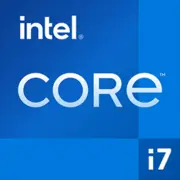Intel Core i7-13700H

Intel Core i7-13700H: A Powerful Hybrid Processor for Mobile Tasks
March 2025
Since the announcement of Intel's hybrid architecture, Alder Lake, the company has continued to develop the concept of combining performance cores and energy-efficient cores. The Intel Core i7-13700H, introduced in 2023, remains a relevant solution for high-end laptops even two years later. In this article, we will discuss what sets it apart, who it is suitable for, and how it compares to competitors in 2025.
Architecture and Process Technology: Hybrid Power of Raptor Lake
Cores, Threads, and Cache
The Core i7-13700H belongs to the Raptor Lake generation and is manufactured using the Intel 7 process technology (10nm Enhanced SuperFin). Its hybrid architecture includes:
- 6 performance cores (P-cores) with Hyper-Threading support (12 threads);
- 8 energy-efficient cores (E-cores) without Hyper-Threading (8 threads);
- Total: 14 cores and 20 threads.
The base frequency of the P-cores is 2.4 GHz, with a maximum turbo frequency of 5.0 GHz. The E-cores operate at 1.8–3.7 GHz. This approach allows for effective task allocation: P-cores handle heavy applications, while E-cores manage background processes, improving overall system responsiveness.
Cache Memory: The 24 MB L3 cache (20% larger than the predecessor i7-12700H) speeds up data processing in multi-threaded scenarios.
Integrated Graphics
The integrated Intel Iris Xe (96 EU) GPU provides basic performance for:
- Working with 4K video;
- Running games at low settings (e.g., CS:GO — 60-80 FPS at Full HD);
- Accelerating rendering in Adobe Premiere via Quick Sync.
For AAA games or 3D modeling, a discrete graphics card (e.g., RTX 4060 or Arc A770M) will be necessary.
Energy Consumption and TDP: Balancing Power and Efficiency
The nominal TDP of the processor is 45W, but in reality, laptops with the i7-13700H can set this parameter within the range of 35–65W depending on the cooling system. For instance:
- In ultrabooks (e.g., ASUS ZenBook Pro 14), TDP is limited to 35W to reduce heat;
- In gaming models (e.g., MSI Katana 15), the processor operates at 65W, increasing turbo mode frequencies.
Energy-Saving Technologies:
- Intel Dynamic Tuning — automatically adjusts power based on load;
- Adaptix — optimizes performance for specific applications;
- Windows operating modes (Power Saver/ Balanced/ Performance) affect core behavior.
Performance: Real Scenarios and Turbo Mode
Benchmarks and Practical Tests
- Geekbench 6: 2454 (Single-Core), 12947 (Multi-Core). For comparison: Apple M2 Pro — 2650 (SC), 14200 (MC).
- Cinebench R23: 1850 (SC), 17500 (MC).
- Rendering in Blender (BMW Scene): 4 minutes and 20 seconds (15% faster than Ryzen 7 7840HS).
Everyday Tasks
- Office Work: Simultaneous use of 50+ tabs in Chrome, Excel sheets, and Zoom — without lags.
- Multimedia: Converting 1-hour 4K video to 1080p using HandBrake — 22 minutes.
- Gaming: Together with RTX 4060 — Cyberpunk 2077 on high settings in Full HD — 65-75 FPS.
Turbo Mode lasts for 2-3 minutes under load, after which frequencies decrease by 10-15% due to heat. In laptops with advanced cooling (e.g., Lenovo Legion 5 Pro), the drop is less noticeable.
Use Cases: Who is the i7-13700H Designed For?
1. Professionals:
- Video editors (Premiere Pro, DaVinci Resolve);
- Engineers (AutoCAD, SolidWorks);
- Developers (code compilation, virtualization).
2. Gamers: In combination with a discrete GPU — games at high settings.
3. General Users: Those who value speed in multitasking (streaming, graphics work + browsing).
Battery Life: How Long Will the Battery Last?
At a TDP of 45W, battery life depends on battery capacity and optimization:
- Laptops with 70–80 Wh:
- Video playback (YouTube, 50% brightness) — 6–7 hours;
- Office tasks — 5–6 hours;
- Gaming — 1.5–2 hours.
Power-Saving Technologies:
- Intel Speed Shift — instantaneous switching between processor states;
- Connected Standby — reduces power consumption in standby mode.
Tip: To increase battery life, choose models with IPS displays at 60 Hz (instead of 144 Hz) and large batteries (e.g., Dell XPS 15 with 86 Wh).
Comparison with Competitors: Who Does the i7-13700H Outperform?
1. AMD Ryzen 7 7840HS (Zen 4):
- Pros: Better energy efficiency, longer battery life.
- Cons: Weaker in single-threaded tasks (Geekbench SC: 2300).
- Laptop prices: $1300–1700.
2. Apple M2 Pro:
- Pros: Record battery life, quiet operation.
- Cons: Limited compatibility with Windows software.
- Price: Starting at $2000.
3. Intel Core i7-12700H:
- The i7-13700H is 12–18% faster in multi-threaded scenarios.
Pros and Cons of the Processor
Strengths:
- High multi-threaded performance;
- Support for DDR5-5200 and PCIe 5.0;
- Versatility (gaming, work, creativity).
Weaknesses:
- Heating under prolonged load;
- Dependence on the laptop’s cooling system;
- Battery life lags behind Ryzen 7 and Apple M2.
Recommendations for Laptop Selection
1. Type of Device:
- Gaming Laptop (MSI, ASUS ROG) — for maximum performance.
- Workstation (Lenovo ThinkPad P16) — reliable cooling, accurate display.
- Ultrabook (HP Spectre x360) — a compromise between portability and power.
2. What to Pay Attention To:
- Cooling system (at least 2 fans + copper pipes);
- Screen: 100% sRGB for design, 144 Hz for gaming;
- Ports: Thunderbolt 4, HDMI 2.1.
Examples of 2025 Models:
- Acer Predator Helios 16 ($1600): i7-13700H + RTX 4070, 16 GB DDR5.
- Microsoft Surface Laptop Studio 2 ($1800): 120 Hz display, touchscreen.
Final Conclusion: Is it Worth Getting a Laptop with the i7-13700H?
This processor is suitable for those looking for versatility without being tied to the Apple ecosystem. Its key advantages include:
- Power for professional tasks and gaming;
- Support for modern standards (DDR5, PCIe 5.0);
- Wide availability in various price categories ($1200–$2000).
If you can tolerate heating under load and do not require 10-hour battery life, the i7-13700H will be an excellent choice for the next 3–4 years.
Basic
CPU Specifications
Memory Specifications
GPU Specifications
Benchmarks
Compared to Other CPU
Share in social media
Or Link To Us
<a href="https://cputronic.com/cpu/intel-core-i7-13700h" target="_blank">Intel Core i7-13700H</a>